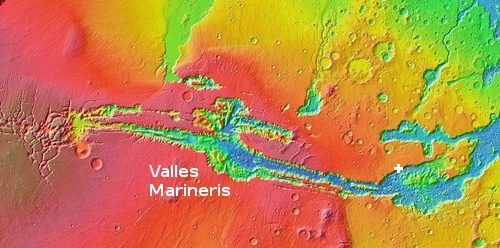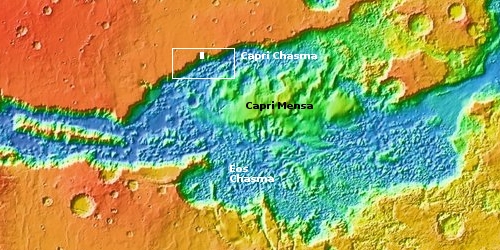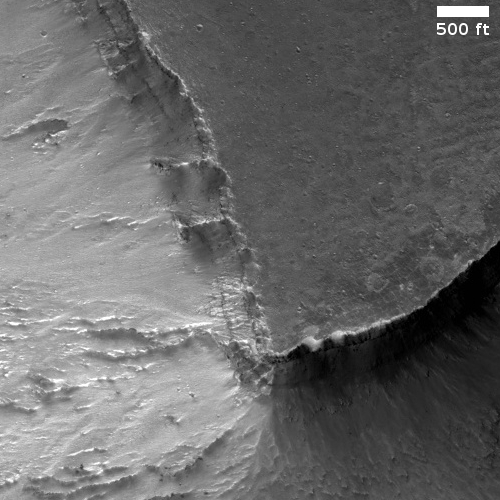On the rim of Mars’ Grand Canyon
Cool image time! Mars has many grand geological features that will surely attract tourists in the far future, when the planet has been successfully colonized and humans live there with the same ease that we today live in what was the New World wilderness several hundred years ago.
Of those features, none probably compare with Valles Marineris, the largest known canyon in the solar system. When compared to it, the Grand Canyon — at about a mile deep, about ten miles wide, and about 280 miles long — is a mere pothole, hardly noticeable. Valles Marineris averages a depth of five miles, a width of 370 miles, and a length of 1,900 miles. You could fit many Grand Canyons within it.
The photo to the right, cropped to post here, was taken on July 13, 2020 by the high resolution camera on Mars Reconnaissance Orbiter (MRO). It shows only a tiny section of this gigantic canyon’s rim. At this spot the depth from rim to floor is about 4.3 miles, or about 22,700 feet. In the image itself I estimate the cliff at the rim to be somewhere between 6,000 to 8,000 feet high, more than the depth of the entire Grand Canyon. And that’s only this top cliff.
The three overview maps below show the context of this location within Valles Marineris.



The top overview map provides a view of Valles Marineris in its entirety, with the location of today’s image indicated by the white cross. The middle overview map zooms in on this particular part of Valles Marineris. The canyon in general is so large its interior canyons and mountains have their own names. At this point, the canyon’s width from the north rim to the narrow peninsula to the south is about 120 miles. Since Eos Chasma has a length of about 300 miles, the entire Grand Canyon could fit into it, with lots of room to spare.
The white rectangle with the small white box within it shows the area covered by the bottom overview map, with the image above indicated by the red box.
For the planetary scientists, this image is of interest because of the layers visible in that cliff wall. Even at this resolution, about 10 inches per pixel, at least two dark bands can be seen in the west-facing cliff, with several thinner bands hinted at.
It is believed [pdf] that the dark layers are lava flows, with the lighter layers between ash deposits, all built up by different volcanic events over time. Though scientists have not yet completed a full map of these layers, the first rough geological work estimates numerous eruption events and lava flows, covering more than a billion years, from about 3 to 4 billion years ago.
None of these conclusions however are certain. For example, while there is more certainty that the dark layers are hardened lava, the lighter and weaker layers between might not be volcanic ash. There is not enough good data yet to be certain.
If true however they suggest that Mars had volcanic eruptions of a size and extent that dwarf anything found on Earth. Nor should we be surprised, considering that just to the west of this humongous canyon are Mars’ largest volcanoes, also the biggest in the solar system.
On Christmas Eve 1968 three Americans became the first humans to visit another world. What they did to celebrate was unexpected and profound, and will be remembered throughout all human history. Genesis: the Story of Apollo 8, Robert Zimmerman's classic history of humanity's first journey to another world, tells that story, and it is now available as both an ebook and an audiobook, both with a foreword by Valerie Anders and a new introduction by Robert Zimmerman.
The print edition can be purchased at Amazon or from any other book seller. If you want an autographed copy the price is $60 for the hardback and $45 for the paperback, plus $8 shipping for each. Go here for purchasing details. The ebook is available everywhere for $5.99 (before discount) at amazon, or direct from my ebook publisher, ebookit. If you buy it from ebookit you don't support the big tech companies and the author gets a bigger cut much sooner.
The audiobook is also available at all these vendors, and is also free with a 30-day trial membership to Audible.
"Not simply about one mission, [Genesis] is also the history of America's quest for the moon... Zimmerman has done a masterful job of tying disparate events together into a solid account of one of America's greatest human triumphs."--San Antonio Express-News
Cool image time! Mars has many grand geological features that will surely attract tourists in the far future, when the planet has been successfully colonized and humans live there with the same ease that we today live in what was the New World wilderness several hundred years ago.
Of those features, none probably compare with Valles Marineris, the largest known canyon in the solar system. When compared to it, the Grand Canyon — at about a mile deep, about ten miles wide, and about 280 miles long — is a mere pothole, hardly noticeable. Valles Marineris averages a depth of five miles, a width of 370 miles, and a length of 1,900 miles. You could fit many Grand Canyons within it.
The photo to the right, cropped to post here, was taken on July 13, 2020 by the high resolution camera on Mars Reconnaissance Orbiter (MRO). It shows only a tiny section of this gigantic canyon’s rim. At this spot the depth from rim to floor is about 4.3 miles, or about 22,700 feet. In the image itself I estimate the cliff at the rim to be somewhere between 6,000 to 8,000 feet high, more than the depth of the entire Grand Canyon. And that’s only this top cliff.
The three overview maps below show the context of this location within Valles Marineris.



The top overview map provides a view of Valles Marineris in its entirety, with the location of today’s image indicated by the white cross. The middle overview map zooms in on this particular part of Valles Marineris. The canyon in general is so large its interior canyons and mountains have their own names. At this point, the canyon’s width from the north rim to the narrow peninsula to the south is about 120 miles. Since Eos Chasma has a length of about 300 miles, the entire Grand Canyon could fit into it, with lots of room to spare.
The white rectangle with the small white box within it shows the area covered by the bottom overview map, with the image above indicated by the red box.
For the planetary scientists, this image is of interest because of the layers visible in that cliff wall. Even at this resolution, about 10 inches per pixel, at least two dark bands can be seen in the west-facing cliff, with several thinner bands hinted at.
It is believed [pdf] that the dark layers are lava flows, with the lighter layers between ash deposits, all built up by different volcanic events over time. Though scientists have not yet completed a full map of these layers, the first rough geological work estimates numerous eruption events and lava flows, covering more than a billion years, from about 3 to 4 billion years ago.
None of these conclusions however are certain. For example, while there is more certainty that the dark layers are hardened lava, the lighter and weaker layers between might not be volcanic ash. There is not enough good data yet to be certain.
If true however they suggest that Mars had volcanic eruptions of a size and extent that dwarf anything found on Earth. Nor should we be surprised, considering that just to the west of this humongous canyon are Mars’ largest volcanoes, also the biggest in the solar system.
On Christmas Eve 1968 three Americans became the first humans to visit another world. What they did to celebrate was unexpected and profound, and will be remembered throughout all human history. Genesis: the Story of Apollo 8, Robert Zimmerman's classic history of humanity's first journey to another world, tells that story, and it is now available as both an ebook and an audiobook, both with a foreword by Valerie Anders and a new introduction by Robert Zimmerman.
The print edition can be purchased at Amazon or from any other book seller. If you want an autographed copy the price is $60 for the hardback and $45 for the paperback, plus $8 shipping for each. Go here for purchasing details. The ebook is available everywhere for $5.99 (before discount) at amazon, or direct from my ebook publisher, ebookit. If you buy it from ebookit you don't support the big tech companies and the author gets a bigger cut much sooner.
The audiobook is also available at all these vendors, and is also free with a 30-day trial membership to Audible.
"Not simply about one mission, [Genesis] is also the history of America's quest for the moon... Zimmerman has done a masterful job of tying disparate events together into a solid account of one of America's greatest human triumphs."--San Antonio Express-News



Incredible. In the thin, low H2O atmosphere, the view would be even more amazing.
Too bad no limestone in those cliffs!
Ah … a long way from Saturday morning cartoons ….
https://www.youtube.com/watch?v=GTqkQ47VPbY
I suggest that due to the depth of the canyon, the atmospheric pressure is enough to maintain a higher temperature such as is found on Earth where the surface is lower than sea level, think Dead Sea as an example. Boyle’s Law. If this is the case there would be a greater likelihood of liquid water at the surface during some seasons if H2O is present in the canyon. Therefore a greater likelihood of finding some type of life form. To me the hurdles of navigating this type of terrain safely and successfully would be difficult but worthwhile.